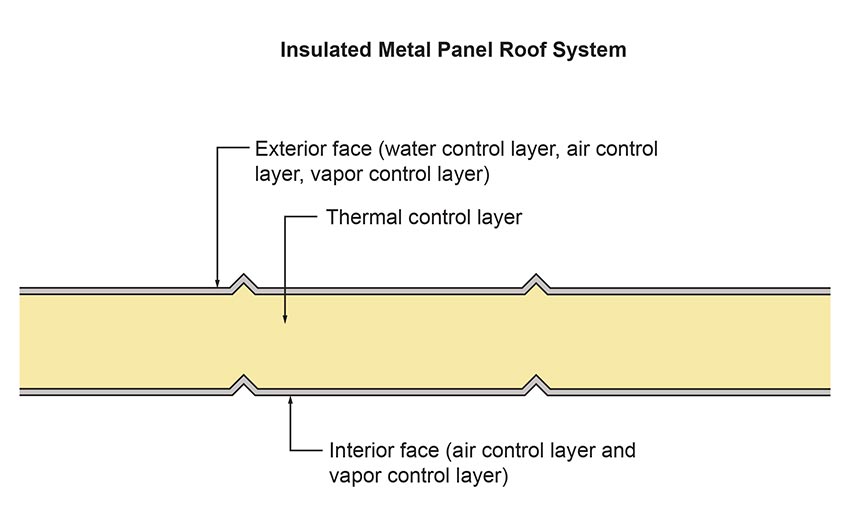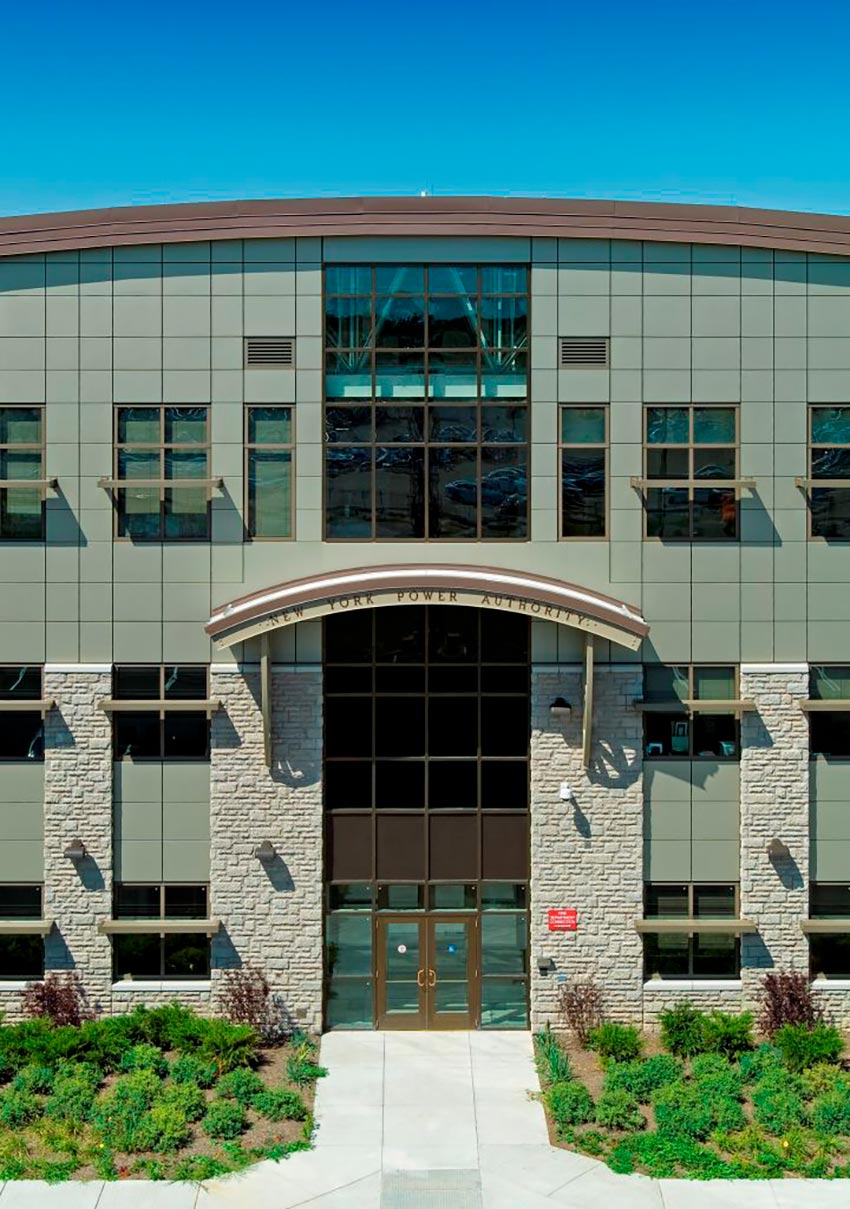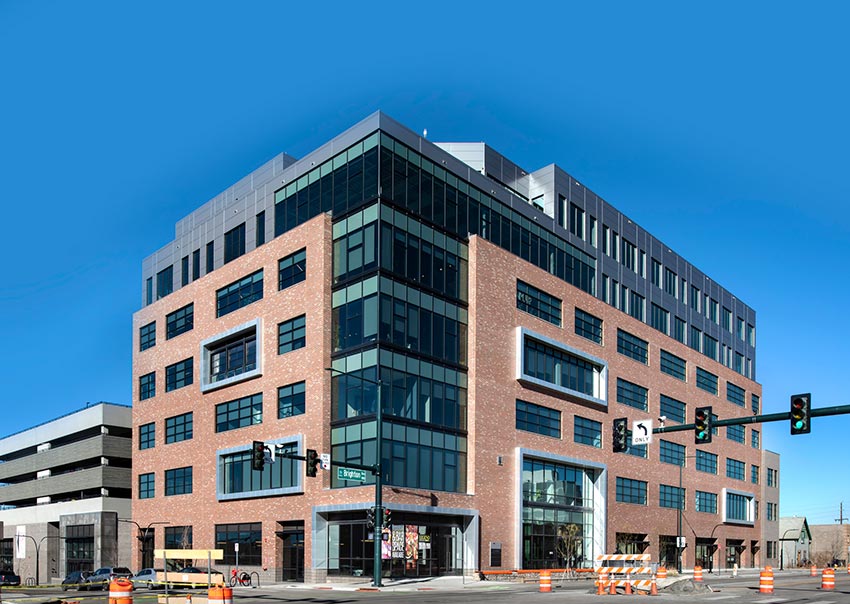This CE Center article is no longer eligible for receiving credits.
Fire Codes and IMPs
Preventing fire and keeping fire damage to a minimum are primary industry and regulatory concerns. Not only must buildings resist and thrive under daily weather and temperature changes, but the best buildings also are resilient and can weather major disasters. The basis for passive fire protection in fire-safety regulation, particularly in U.S. codes, is that all products used in construction must comply with some appropriate fire test suitable for the application.

Photo courtesy of Kingspan
High-rise buildings in particular, such as 1611 West Division in Chicago, fall under intense scrutiny by fire codes. Both individual materials and integrated systems are tested under U.S. regulations.
U.S. codes require that a fire test incorporates every one of the components of the wall assembly, as the product to be used in the field, instead of testing individual components only.
IMPs use a foam plastic core. This core gives IMPs superior insulating properties, providing increased energy efficiency. While foam offers superior thermal performance per unit thickness over noncombustible insulating materials, it is a combustible cladding material and must be tested appropriately according to the IBC.
The fire performance of IMPs is measured via many factors. The metal facing is evaluated for both gauge and the melting point of the facing. The foam core is tested for flame spread, smoke developed, heat of combustion, Btu content, ignition temperatures, polyisocyanurate (PIR) vs. polyurethane (PUR) (ratio of isocyanurateto polyol), density (amount of plastic per volume), thickness, blowing agent type, and amounts and fire retardants. The panel design must be evaluated for joint engagement—male/female interlock depth, joint strength, and geometry of male/female interlock. Attachment methods, including clips and through fasteners, the ability of clips/fasteners to keep joints closed and tight, the use of trims and extrusions or exposed panel edges, and type of sealant, also are examined.
U.S. codes typically require that wall assemblies be fire tested as a complete assembly utilizing the specific combustible components that will be included in the wall. Substitution of components can take place based on additional testing or engineering review. The main focus is how components will work together to resist the spread of fire. In particular, U.S. codes place special emphasis on ensuring the fire safety of foam plastic insulation materials. Foam plastic insulation materials used in construction, including those used as components of assemblies, must comply with the fire safety requirements contained in Chapters 14 and 26 of the IBC.
The foam plastic insulation materials themselves must also be listed and labeled. Listing of a product involves two steps: the conducting of appropriate fire tests to show code compliant results and the assurance that the products are manufactured consistently to continue complying with the code requirements. In order for foam plastic insulation materials to be listed for U.S. construction use, the materials must have complied with a flame-spread index of not more than 75 and a smoke-developed index of not more than 450 (i.e., a Class B) where tested in the maximum thickness intended for use in accordance with ASTM E84 (known frequently as the Steiner tunnel test) or UL 723 (which is an equivalent fire test method).
Fire testing of the foam itself is, of course, just the basic requirement for materials to be able to be considered for use as the core in IMPs or as a component of an acceptable combustible wall-cladding assembly. The complete assembly must also be fire tested using NFPA 285 when used as or on exterior walls of type I, II, III, or IV construction, which are greater than one story in height. One story buildings are exempt from NFPA 285 provided the building is equipped throughout with an automatic sprinkler system (2603.4.1.4). The NFPA 285 fire test evaluates the vertical and lateral flame-propagation potential of any wall system that contains combustible components, typically foam plastic insulation.
Although foam has fallen under the intense scrutiny of building codes, the scrutiny has paid off with safety. The use of IMPs containing foam plastic insulating materials, when they comply with the appropriate fire test requirements for both the components individually and the assembly, have been shown to exhibit excellent fire performance.
Superior insulating properties, which boost energy efficiency; the ability to act as a rainscreen and water barrier; proven fire performance—IMPs fulfill all of the functions of a typical high-performance building enclosure. IMPs bring fire safety, environmental benefits, and design flexibility to any project.
Selecting the Best
IMPs bring a suite of performance characteristics to the table, allowing for high-performance, efficient, sustainable, healthy buildings. Their tested and certified performance mean confidence for the whole building’s resiliency into the future.
However, there are many material options available today. To make a choice with confidence, how do IMPs compare against other common systems for aesthetics, envelope performance, fire safety, and cost and installation?

Photo courtesy of Metl-Span
For the Liberty University Indoor Football Practice Facility in Lynchburg, Virginia, IMPs offered a unique combination of aesthetic flexibility and enclosure performance capabilities.
Decision Points for IMPs and Brick/Brick Veneer
A classic historical building material, today, brick’s use in construction is divided as 80 percent residential, 16 percent nonresidential, and 3 percent paving applications. While market drivers for brick are its low material cost, long life cycle, availability, and durability, it is less common in commercial applications today because of higher labor costs and slower construction speed. Brick also is difficult to insulate to meet current energy codes and is not suitable for areas of seismic activity.
Brick veneer assemblies are the most common use of brick in commercial construction today. This assembly consists of a single nonstructural, external layer of brick backed by an air space. Because it is nonstructural, it must be tied back to the building to prevent movement under wind and seismic loads. There are many variations of brick veneer construction, depending on construction codes and building use. These can include brick veneer with an insulated stud cavity, brick veneer with exterior rigid board over stud wall, brick veneer with exterior rigid board over CMU block, and even brick veneer placed over IMPs.
This course is part of the Metal Architecture Academy
The buildings of today must satisfy a supreme standard: they are called upon to achieve high performance: to be resilient, healthy, and energy efficient. Building science has focused modern design emphasis on the “envelope” in response to the movement of air, water vapor, and thermal conditions. These demands elicit dramatic changes to building envelope designs and the components used within.
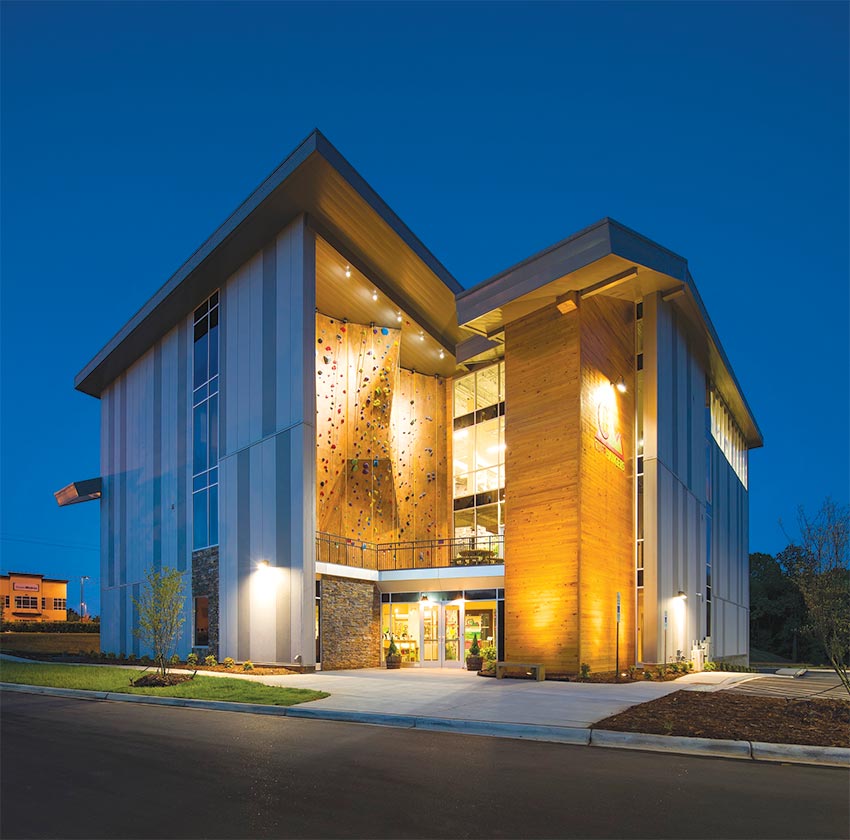
Photo courtesy of Metl-Span
To be sustainable and resilient, the buildings of today need to be built with materials that have the future in mind. Pictured is Cliff Hangers facility in Mooresville, North Carolina.
Understanding how to deliver high-performance, code-compliant buildings can be complex and confusing. Not only are architects charged with satisfying performance and structural requirements, but, in order to meet these conditions, the contemporary envelope also may now incorporate increased amounts of combustible materials in cladding, insulation, and water-resistive barriers (WRBs). Since fire-performance requirements have become integral with updates to the International Building Code (IBC), this adds yet another layer of complexity.
With demands on a structure at their highest, what products or systems can fulfill all of the required air and water control functions of a high-performance building enclosure, while meeting the building codes and still offering aesthetic flexibility?
Defining IMPs
What They Are
Future-oriented buildings require future-oriented products. Insulated metal panels (IMPs) are lightweight systems of exterior wall and roof panels with metal skins and insulating foam cores. First developed by the National Aeronautics and Space Administration (NASA), these panels have superior insulating properties, and their outstanding spanning capabilities and one-pass installation makes them quick to install, providing unit cost savings when compared to other wall assemblies.
To deliver their high-performance insulation, foam is injected, or poured in place, between two metal sheets, where it then undergoes a chemical reaction, causing it to expand and bond to the metal skins, thereby completely filling the interior cavity between the metal skins. The result is a solid panel system that provides superior thermal value and resists moisture, insect, and rodent infiltration.
IMPs are available in a wide variety of colors, widths, profiles, and finishes, enabling the realization of virtually any desired aesthetic for walls and roofs. IMPs can also be curved and formed, and they come in a variety of high-performance coatings.
Expanding upon the various profiled options, designers can choose walls that are ribbed, fluted, or planked. For flat walls, finishes can be flat, textured, or striated.
Additional design features include joint reveal widths, formed corner panels, end folds and treatments, heavier-gauge flat facings, and integrated windows and louver systems. Another available finish feature is embossing, which creates surface texture on metal coils. This process flattens wavy coils and eliminates the “mirror” effect of smooth finishes. It is also a useful way to mask minor blemishes such as paint scratches and surface variations. Nondirectional embossing can be applied to create a uniform pattern, whereas directional embossing produces linear lines along the length of the coil.
The most commonly used metal substrates for IMP faces are G90 galvanized steel or AZ50 aluminum-zinc coated steel, while some custom panels are made from stainless steel or aluminum.
For the interior, a typical finish is a standard polyester 0.8 millimeter—including the primer—in a light-reflective and easy-to-maintain color. United States Department of Agriculture (USDA)-compliant finishes and stainless steel also are available for required applications, such as food processing and storage.
Performance wise, architects are able to specify various panel insulation values, span lengths, and load/span capabilities.
In the field, IMPs are not only considered the primary exterior finish but now also are being designed as the primary building envelope and can be clad with various secondary rainscreen materials, such as brick veneer.
Where They’re Found
- Commercial and industrial: IMPs are ideal for all types of commercial and industrial buildings, including institutional, recreational, government buildings, and manufacturing facilities. Projects from schools to retail centers to power plants benefit from the unique energy-efficient insulation, lightweight construction, durability, and cost-effective, timely installation of single-component IMPs. IMPs also provide solutions for a variety of climate considerations, including temperature, humidity, airborne particles, and air movement, among others.
- Architectural: Architectural IMPs have the normal attributes of those used in commercial and industrial builds, such as high insulation values, speed of build, and vertical and horizontal applications, but they also incorporate options such as custom shapes and widths, specialized colors and finishes, and custom fabrication, including, but not limited to, factory-bended corners, curved panels, and trimless ends. Architectural IMPs offer options that can incorporate panels that coalesce with windows, louvers, sunshades, or other integrated products to offer total building envelope solutions. Their flexibility provides architects freedom to create unique building designs.
- Cold storage: IMPs are considered the ultimate solution for climate-controlled facilities. Whether the need is for manufacturing, processing, storage, or distribution of perishable food or other materials, an IMP wall can meet the demands. Available in panel thicknesses from 2–6 inches, a wall can be designed to meet specific thermal performance requirements. Additional features include long spanning capability, flat and ribbed shaped panels, high-performance coatings, and special joint designs and details to meet safe hygiene and contamination requirements.
- Insulated roof: IMPs are the roofing solution that provides the greatest insulation, simplest maintenance, and longest life coupled with quickest installation for low- and high-rise commercial and industrial applications. The essentially two-step installation process limits exposure to accidents and reduces the number of installation steps and materials required, increasing the speed of installation and reducing down time while providing a roof with superior insulation properties that can last more than four decades.
IMPs and the Building Enclosure
IMPs offer more than aesthetic flexibility. As a turnkey option that delivers a full vapor and water barrier—along with continuous insulation—IMPs also are an easy way to meet the growing and vital body of code requirements. Codes today focus not only on safety (things like fire requirements) and sustainability but also on performance and building health.
In a 2010 Building Science Corporation article titled “BSI-001: The Perfect Wall,” Joseph Lstiburek, Ph.D., ASHRAE Fellow, writes: “The perfect wall is an environmental separator. It has to keep the outside out and the inside in. In order to do this, the wall assembly has to control rain, air, vapor, and heat. Today, walls need four principal control layers. They are presented in order of importance: a rain control layer, an air control layer, a vapor control layer, and a thermal control layer. A point to this importance: If you can’t keep the rain out, don’t waste your time on the air. If you can’t keep the air out, don’t waste your time on the vapor.”
For Lstiburek, the perfect wall has the rain control layer, the air control layer, the vapor control layer, and the thermal control layer on the exterior of the structure. The cladding’s function principally is to act as an ultraviolet screen.
The best place for control layers is to locate them on the outside of the structure in order to protect it.
IMPs are a type of “perfect wall,” due to the location of their control layers. Water, air, and vapor control layers are all located on the exterior of the structure, with thermal control located inboard structure along with duplicate air and vapor control layers. Because of this construction, IMPs can be used in all climate zones: cold, mixed, hot, humid, dry, or marine. IMPs also work for the demands of all interior environments: office, commercial, residential, institutional, pools, museums, art galleries, and data-processing centers.
IMPs can be used as a rainscreen barrier wall system and integrated with other wall and roof systems while still maintaining proper control-layer continuity.
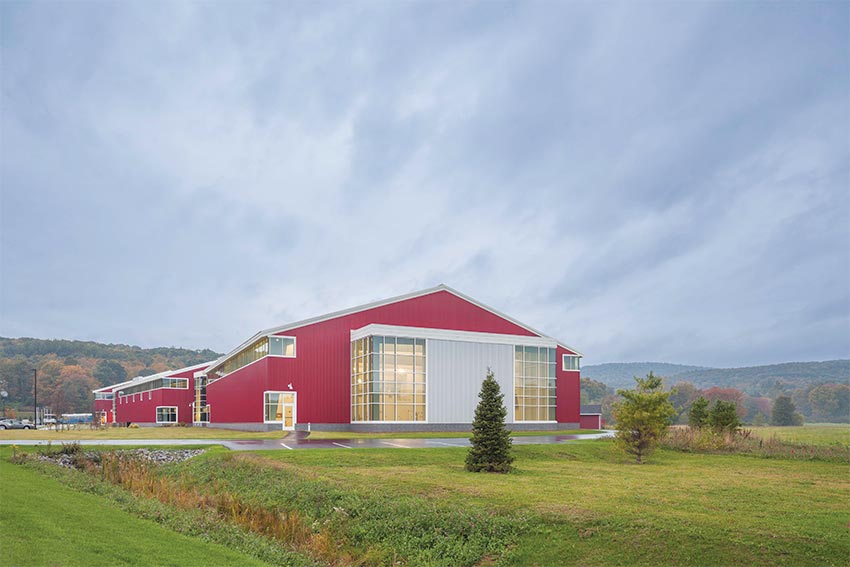
Photo courtesy of Kingspan
Insulated metal panels (IMPs) offer a type of “perfect wall” in one component, controlling for rain, air, vapor, and thermal conditions, as shown here at the Keene Family YMCA in New Hampshire.
IMPs provide all four control layers within a single component, meaning they do not require the use of supplemental air/water/vapor or thermal control layers. Depending on climate zone and special requirements, IMPs can be used with supplemental cavity insulation subject to ratios listed in the IBC.
Guaranteeing Performance: General Codes and Properties of IMPs
Placing a product in a building means betting the future of the structure on that product’s performance. Three major standards apply to IMPs and are used to satisfy IBC Chapter 26 requirements:
- FM Approvals 4471 approval standard for roofs (fire and uplift);
- FM Approvals 4880 approval standard for walls and roofs (fire only); and
- FM Approvals 4881 approval standard for exterior walls (fire and structural).
Under Chapter 14, NFPA 285 Standard Fire Test Method for Evaluation of Fire Propagation Characteristics of Exterior Wall Assemblies Containing Combustible Components is critical for compliance.
When an IMP panel meets required certifications and codes, the entire assembly has been put to the test. Everything from the metal facings and metal gauge’s thickness and tensile and yield properties; to foam core properties, including cohesion (how well foam sticks to itself when pulled apart), compression (how well foam holds up under pressure), and adhesion (how well foam sticks to metal skins); to panel design (joint engagement, including male/female interlock depth and joint strength; geometry of male/female interlock, width of panels, including distance between side joints and thickness; and distance between skins); and finally, attachment methods (clip strength, clip fit and placement within joint, load-bearing area of clip, pullout strength of fasteners, pullout resistance of structural supports) is analyzed.
Engineering safety factors are determined by building codes, industry practices, general engineering principles, or ICC-ES Acceptance Criteria. For IMPs, overall panel strength is determined by the following laboratory tests:
- ASTM E72-10: Standard Test Methods of Conducting Strength Tests of Panels for Building Construction; and/or
- ASTM E330–E330M-14: Standard Test Method for Structural Performance of Exterior Windows, Doors, Skylights and Curtain Walls by Uniform Static Air Pressure Difference.
Insulating Capabilities of IMPs
Keeping the outside out and maintaining the comfort inside is one of the principle jobs of the building envelope. The ANSI/ASHRAE/IES Standard 90.1: Energy Standard for Buildings Except Low-Rise Residential Buildings shows a clear trend for continuous insulation, specifically in zones 5–8. Continuous insulation is the best method to improve thermal performance. Properly installed, it increases the effective R-value of the wall system. Continuous insulation blocks thermal bridging (heat transfer) created by common types of exterior wall construction.
The primary reason foam plastic insulation materials are extensively used in building construction is that they tend to provide a higher insulating value per inch than many other materials. IMPs generally use a foamed-in-place or polyisocyanurate foam plastic insulation, at thicknesses of 2–4 inches, achieving R-values in place of up to 45. This type of material can provide a thermal resistance value (R-value) of 7 per inch (nom.), compared to values of between 2 to 4 for fiberglass or mineral wool. High R-values are a driving reason behind the popularity of foam plastic insulation materials.
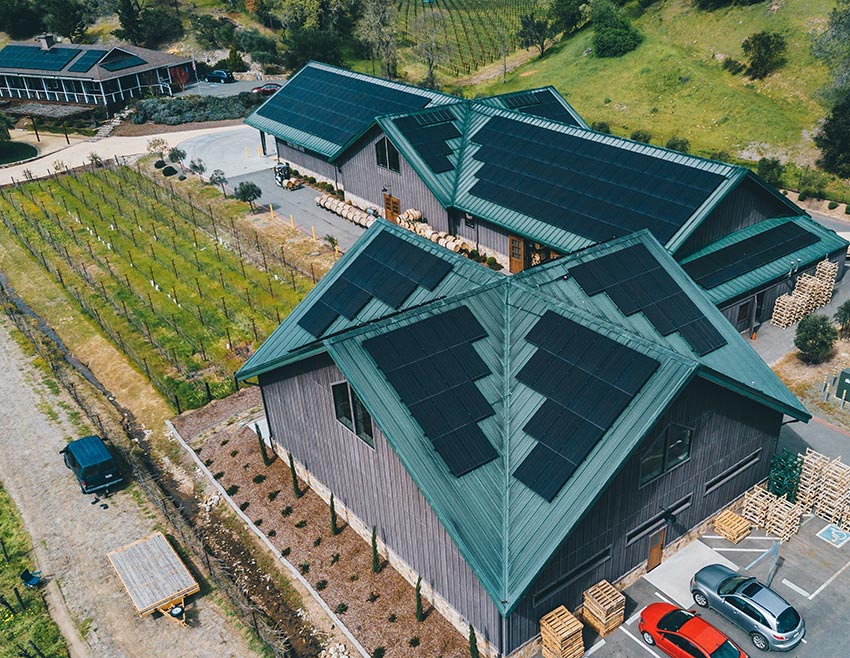
Photo courtesy of All Weather Insulated Panels
IMPs offer excellent insulating values and protect against thermal bridging losses, as shown here at the Verge Winery in California.
Additional insulation may be added to IMPs based upon a WUFI analysis, which evaluates the action of heat and moisture in walls, to meet other specified requirements. WUFI is a computer program that can tell how moisture and heat flow affect building materials over time. IMP systems, by virtue of their joint geometry, address thermal bridging in a more robust manner than typical site-built assemblies for walls and roofs, a design asset for maintaining thermal performance. Thermal bridging occurs when there is a break in a building’s insulation, so it is important to carefully consider the joint detailing when selecting a system.
Water- and Air-Barrier Capabilities of IMPs
The most important nonstructural and non-fire-performance aspect of any wall system is its ability to control rainwater, according to Lstiburek. Historically, the most widely used method of controlling rainwater is by installing claddings over IMP systems, providing a continuous water control layer coupled with a continuous drained air gap over this water control layer. Because of this history of past performance in application, IMPs are widely recognized for their water- and air-barrier capabilities.
Two major ASTM standards are used to evaluate air and water performance of IMP wall assemblies: ASTM E283-04 (2012): Standard Test Method for Determining Rate of Air Leakage Through Exterior Windows, Curtain Walls, and Doors Under Specified Pressure Differences Across the Specimen and ASTM E331-00 (2009): Standard Test Method for Water Penetration of Exterior Windows, Skylights, Doors, and Curtain Walls by Uniform Static Air Pressure Difference.
Roof assemblies are evaluated by their own ASTM standards for air and water performance: ASTM E1680-11: Standard Test Method for Rate of Air Leakage Through Exterior Metal Roof Panel Systems (Specialized adaptation of E283) and ASTM E1646-95 (2011): Standard Test Method for Water Penetration of Exterior Metal Roof Panel Systems by Uniform Static Air Pressure Difference (specialized adaptation of E331).
To best leverage the insulating and water- and air-barrier capabilities of IMP systems, it is important to pay close attention to how the system interfaces holistically. Paul Collyer, vice president of business development for Cornerstone Building Brands in Denver, emphasizes that when dealing with any type of barrier wall, it is important to maintain continuity of control layers—specifically air, vapor, water, and thermal. “Proper details showing how the barrier system should interface with penetrations, material transitions, etc. are critical to proper envelope performance,” he says.
Fire Codes and IMPs
Preventing fire and keeping fire damage to a minimum are primary industry and regulatory concerns. Not only must buildings resist and thrive under daily weather and temperature changes, but the best buildings also are resilient and can weather major disasters. The basis for passive fire protection in fire-safety regulation, particularly in U.S. codes, is that all products used in construction must comply with some appropriate fire test suitable for the application.

Photo courtesy of Kingspan
High-rise buildings in particular, such as 1611 West Division in Chicago, fall under intense scrutiny by fire codes. Both individual materials and integrated systems are tested under U.S. regulations.
U.S. codes require that a fire test incorporates every one of the components of the wall assembly, as the product to be used in the field, instead of testing individual components only.
IMPs use a foam plastic core. This core gives IMPs superior insulating properties, providing increased energy efficiency. While foam offers superior thermal performance per unit thickness over noncombustible insulating materials, it is a combustible cladding material and must be tested appropriately according to the IBC.
The fire performance of IMPs is measured via many factors. The metal facing is evaluated for both gauge and the melting point of the facing. The foam core is tested for flame spread, smoke developed, heat of combustion, Btu content, ignition temperatures, polyisocyanurate (PIR) vs. polyurethane (PUR) (ratio of isocyanurateto polyol), density (amount of plastic per volume), thickness, blowing agent type, and amounts and fire retardants. The panel design must be evaluated for joint engagement—male/female interlock depth, joint strength, and geometry of male/female interlock. Attachment methods, including clips and through fasteners, the ability of clips/fasteners to keep joints closed and tight, the use of trims and extrusions or exposed panel edges, and type of sealant, also are examined.
U.S. codes typically require that wall assemblies be fire tested as a complete assembly utilizing the specific combustible components that will be included in the wall. Substitution of components can take place based on additional testing or engineering review. The main focus is how components will work together to resist the spread of fire. In particular, U.S. codes place special emphasis on ensuring the fire safety of foam plastic insulation materials. Foam plastic insulation materials used in construction, including those used as components of assemblies, must comply with the fire safety requirements contained in Chapters 14 and 26 of the IBC.
The foam plastic insulation materials themselves must also be listed and labeled. Listing of a product involves two steps: the conducting of appropriate fire tests to show code compliant results and the assurance that the products are manufactured consistently to continue complying with the code requirements. In order for foam plastic insulation materials to be listed for U.S. construction use, the materials must have complied with a flame-spread index of not more than 75 and a smoke-developed index of not more than 450 (i.e., a Class B) where tested in the maximum thickness intended for use in accordance with ASTM E84 (known frequently as the Steiner tunnel test) or UL 723 (which is an equivalent fire test method).
Fire testing of the foam itself is, of course, just the basic requirement for materials to be able to be considered for use as the core in IMPs or as a component of an acceptable combustible wall-cladding assembly. The complete assembly must also be fire tested using NFPA 285 when used as or on exterior walls of type I, II, III, or IV construction, which are greater than one story in height. One story buildings are exempt from NFPA 285 provided the building is equipped throughout with an automatic sprinkler system (2603.4.1.4). The NFPA 285 fire test evaluates the vertical and lateral flame-propagation potential of any wall system that contains combustible components, typically foam plastic insulation.
Although foam has fallen under the intense scrutiny of building codes, the scrutiny has paid off with safety. The use of IMPs containing foam plastic insulating materials, when they comply with the appropriate fire test requirements for both the components individually and the assembly, have been shown to exhibit excellent fire performance.
Superior insulating properties, which boost energy efficiency; the ability to act as a rainscreen and water barrier; proven fire performance—IMPs fulfill all of the functions of a typical high-performance building enclosure. IMPs bring fire safety, environmental benefits, and design flexibility to any project.
Selecting the Best
IMPs bring a suite of performance characteristics to the table, allowing for high-performance, efficient, sustainable, healthy buildings. Their tested and certified performance mean confidence for the whole building’s resiliency into the future.
However, there are many material options available today. To make a choice with confidence, how do IMPs compare against other common systems for aesthetics, envelope performance, fire safety, and cost and installation?

Photo courtesy of Metl-Span
For the Liberty University Indoor Football Practice Facility in Lynchburg, Virginia, IMPs offered a unique combination of aesthetic flexibility and enclosure performance capabilities.
Decision Points for IMPs and Brick/Brick Veneer
A classic historical building material, today, brick’s use in construction is divided as 80 percent residential, 16 percent nonresidential, and 3 percent paving applications. While market drivers for brick are its low material cost, long life cycle, availability, and durability, it is less common in commercial applications today because of higher labor costs and slower construction speed. Brick also is difficult to insulate to meet current energy codes and is not suitable for areas of seismic activity.
Brick veneer assemblies are the most common use of brick in commercial construction today. This assembly consists of a single nonstructural, external layer of brick backed by an air space. Because it is nonstructural, it must be tied back to the building to prevent movement under wind and seismic loads. There are many variations of brick veneer construction, depending on construction codes and building use. These can include brick veneer with an insulated stud cavity, brick veneer with exterior rigid board over stud wall, brick veneer with exterior rigid board over CMU block, and even brick veneer placed over IMPs.
Aesthetics
Brick is available in a large range of solid or variegated colors and offers good color stability with a typically matte finish. It can be painted or stained after installation.
IMPs offer long-lasting, durable finishes with warranties of up to 35 years or more and can use PVDF (Kynar), FEVE (fluoropolymer based), SMP (silicone modified polyester), polyester, and plastisol finishes. Standard 1-mil and high-build systems offer different finishes, including mica, metallic, weathered metal, wood grain, and prismatic. Long-lasting, low-maintenance paint finishes in a multitude of colors provide design flexibility.
While brick offsets can create depth, there is no practical means of creating exterior profiles. IMP profiles are more easily available due to their roll forming manufacturing process. Easy-to-vary modules, reveal sizes, and thickness add architectural interest.
Envelope Performance
IMPs and brick veneer walls constructed with drained and back-ventilated rainscreens (DBVRs) provide excellent liquid water management. While brick veneers absorb some water, in most circumstances, this dries out through evaporation.
IMPs resist water infiltration through their construction, using gravity to shed water and sealed, protected joints to resist wind-driven rain. As a complete perfect wall system, with designed-in rain, air, vapor, and thermal barriers, IMPs are designed and built to prevent intrusion and dry appropriately, keeping a building healthy and durable. IMPs additionally offer the best protection against air-transported moisture.
IMPs typically have a higher R-value per-inch rating than brick veneer systems. Brick veneer systems rely on the installation of insulation in the field for their thermal performance. This insulation may be instantly degraded based upon site conditions and damage or improper installation. IMPs also demonstrate increased insulating values as the mean temperature decreases, a critical feature in cold climates.
When using brick veneer assemblies as the envelope, particular attention must be paid to areas of discontinuity. Air leaks as a result of the multiple, field-installed components can lead to moisture buildup in the cavity and the possibility of condensation and mold growth.
Each IMP panel assembly is tested for air infiltration to ASTM E283, exceeding the code requirement for air barriers. Panels are factory built and of consistent quality, and panel joints provide consistent sealing conditions. Optional exterior joint caulking provides redundancy where needed.
IMPs provide a simpler solution for delivering envelope performance. With all barriers included from the factory, the possibility of installation mistakes and damage is minimized.
Fire
A brick veneer wall assembly can be considered fire resistive, with a 1-hour fire-resistance rating. Two- and 3-hour ratings are available with the use of additional stud framing with gypsum sheathing.
IMPs are suitable for all construction types when used in accordance with Chapter 26 of the International Building Code (IBC). IMPs do require the use of other materials, such as gypsum, to create fire resistive walls. Certain IMP manufacturers do offer IMP systems with a fire rating.
Installation and Initial Cost Comparisons
IMPs allow for a 5 to 15 times faster installation rate per installer than brick. With a typical brick installation rate per person of 80 square feet per day, IMPs boost that to between 375 to 1,250 square feet per day per person. With their factory-included barriers and larger module size, there are fewer components and trades necessary. IMPs are also less subject to weather delays, like rain, snow, or cold temperatures, than brick. Average labor and material unit costs for brick veneer (cladding, insulation, air, vapor, and water barriers, and exterior gypsum) fall between $16 and $22; IMPs average between $10 and $30.
IMPs offer a clear advantage aesthetically and from a performance perspective. Given their low weight, ease of installation, and thermal performance, IMPs are also an ideal retrofit system.
Decision Points for Concrete Tilt-Up and Precast and IMPs
Concrete tilt-up and precast products are a popular solution in today’s commercial building sector, driven forward by their rapid construction rate, general availability, durability, and fire resistance. Panelmet Consulting offers a comparison between these products.
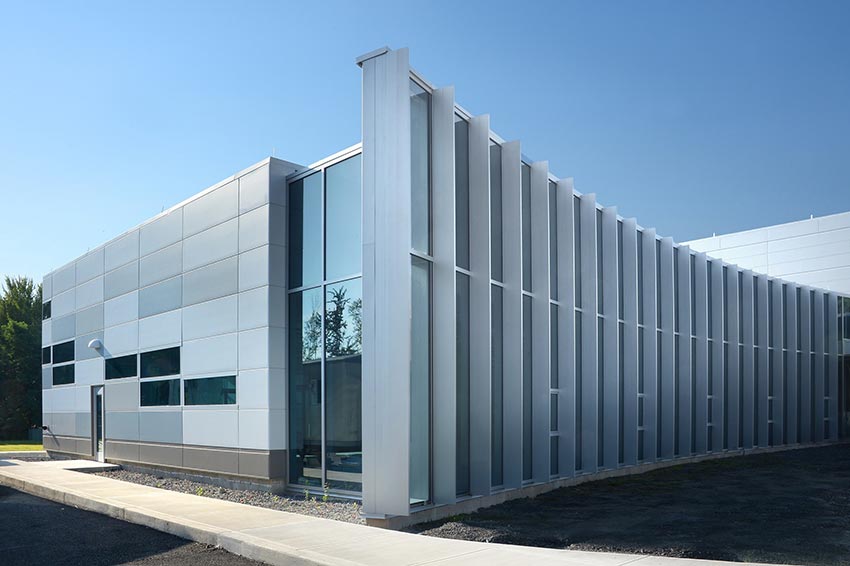
Photo courtesy of Metl-Span
Not only do IMPs offer flexibility in finish, but they can also create exceptional geometries on the facade, as shown here at SORAA Lighting in East Syracuse, New York.
Aesthetics
For concrete tilt-up applications, options are limited to solid colors, which are field applied. The paint has low to medium durability, with no long-term warranties.
As discussed earlier, IMPs offer a large variety of durable and resilient finishes.
Precast and tilt-up concrete offer a range of textured finishes, with tilt-up boasting the greatest variety. Aesthetic options range from smooth to exposed aggregate to plank finishes.
IMPs offer both smooth and stucco finishes.
Tilt-up wall profiles are more difficult to create in the field. Precast offers greater flexibility, but IMPs are a natural fit where a profile is desired. The roll-forming manufacturing process allows for greater creative expression, making IMPs the most practical solution to profile.
Both IMPs and tilt-ups are capable of ornamentation and additional product integration. They can also both accommodate curved wall construction.
Envelope Performance
IMPs and tilt-ups with cavity insulation both provide excellent liquid water management. The use of concrete also provides some thermal mass for a building. However, IMPs provide superior thermal resistance, with an in-place R-value of up to 45, and are also impervious to water. There is no loss of performance due to sagging or compression and virtual elimination of thermal bridging.
IMPs, tilt-ups, and precast with sandwich and cavity systems all provide superior air infiltration performance and vapor diffusion management.
Fire
Tilt-up and precast concrete panels require no modifications for fire resistance. IMPs are suitable for all construction types when used in accordance with the IBC. Of note, however, is the performance of IMPs in high-wind-load areas and seismic areas. Here, IMPs offer superior reliability and disaster resistance.
Installation and Initial Cost Comparisons
Fabrication and installation time combined is fairly comparable between IMPs and tilt-up. Precast project completion is generally faster but more expensive. IMPs are slightly less subject to weather delays than tilt-up.
Average labor and material unit costs for precast are $23; tilt-up runs between $16 and $18. IMPs total from $10 to $30.
As a retrofit solution, IMPs excel given their light weight and design flexibility.
Decision Points for Single Skin and IMPs
After World War II, the excess capacity of the sheet metal sector met a pent-up demand for construction. The product, single skin, facilitated rapid and low-cost construction for factories and other buildings. Today, an increase in available profiles and durable paint finishes have lead to more sophisticated products and applications.
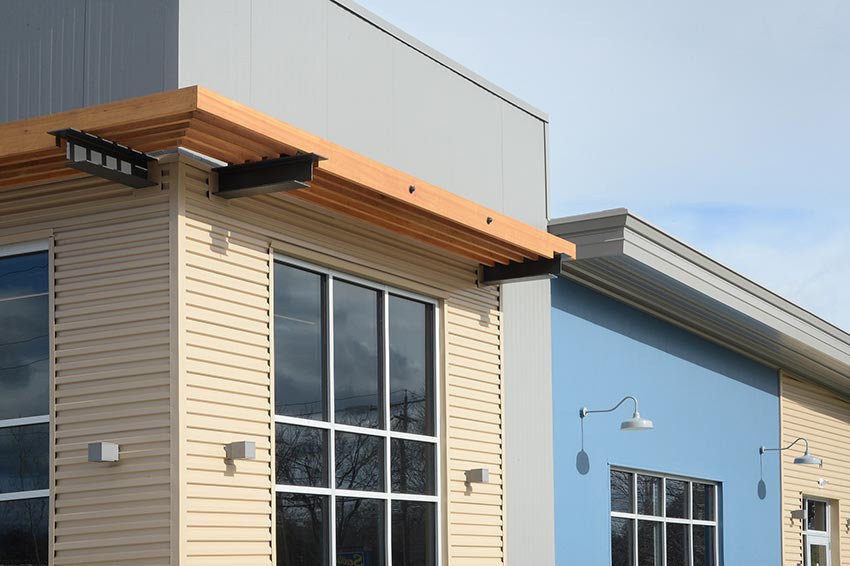
Photo courtesy of Metl-Span
Metal offers a broad and durable range of finish colors as well as the ability to combine distinctive profiles, as shown here at the Land Remediation Building in Waterford, New York.
Aesthetics
Both IMPs and single-skin walls use identical paint systems, offering long-lasting, durable finishes. Single skin offers a greater diversity of profile choices; certain IMP systems can combine with single skins and will accept their profiles. Single skin is also available in more alternative metals, like copper and zinc. IMPs are more difficult to produce with alternative metals due to composite construction, foam adhesion, and fire-related code issues.
IMPs provide better aesthetics for flat panels. Single-skin metal is easier and less expensive to curve than IMPs.
Envelope Performance
IMPs and rainscreen assemblies using single skin both provide excellent water management. The wider, concealed, and fastened IMP structure features less joints than a single-skin facade, meaning less chance for leaks. IMP steel facings provide an ideal drainage plane while exterior and interior joints provide duplicate protection against water intrusion.
IMPs create the ultimate insulating system, straight out of the box. IMPs are impervious to water and have an in-place R-value of up to 45. Their structure further eliminates almost entirely thermal bridging while meeting code requirements for continuous insulation.
Single-skin facades rely on cavity systems added in the field for insulation; the insulation amounts are limited by cavity depth. The added batts or blankets require full expansion to reach their rated R-values and have to contend with the thermal shorts at all structural supports. The taped or foamed seams lose integrity over time. In-place R-values are lower than those offered by IMPs.
Airtightness is critical to envelope performance and a major source of heat loss or gain. Single-skin barrier walls have limited effectiveness due to discontinuities in the air barrier, material transitions, and a lack of redundancy. An IMP panel assembly is tested for air infiltration to ASTM E283 and exceeds code requirement for air barriers. The rigidity of panels and joints provide positive sealing conditions and optional exterior joint caulking provides redundancy. IMPs, therefore, provide superior air infiltration performance. Both IMPs and single-skin barrier walls do provide excellent vapor diffusion.
Installation and Initial Cost Comparisons
Installation times are fairly comparable between IMPs and single-skin walls. Both have similar production rates and are unaffected by weather. High winds can hamper the installation of both systems. While single-skin walls are lighter and easier to maneuver, more components and attachment points occur in the field than IMPs. IMPs offer superior spanning ability versus similarly profiled single skins.
Among the product options available today, IMPs uniquely provide all of the following performance attributes in one easy-to-install package: air-infiltration control, vapor management, water management, thermal performance, paint-finish longevity, structural performance (long spans, wind, snow, and seismic loads), building security, and fire performance (combustible and noncombustible construction).
Creating the Perfect Wall
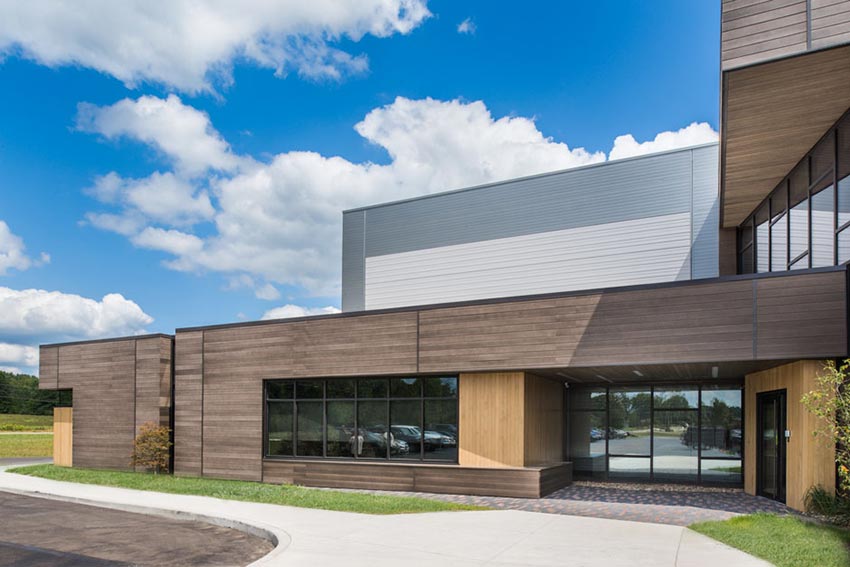
Photo courtesy of Metl-Span
Among the product options available today, IMPs uniquely provide all of the performance attributes in one easy-to-install, aesthetically flexible package.
Future-proofing means designing a building to meet today’s code criteria as well as one that will perform with resiliency into the future. The innovation of IMPs allows architects to design and send a building into the future with confidence. IMPs are a fit for all climate zones and interior conditions, with the ability to provide all necessary building control layers as a single component without the use of supplemental systems. IMPs are also easily integrated with other wall and roof systems by connecting control layers. Their aesthetic range means design flexibility; ease of installation both helps initial costs and guarantees preservation of a building enclosure’s performance.
Future-oriented buildings require future-oriented products. The portfolio provided by IMPs answers the call of the future.
Amanda Voss, MPP, is an author, editor, and policy analyst. Writing for multiple publications, she also currently serves as the managing editor for Energy Design Update.





